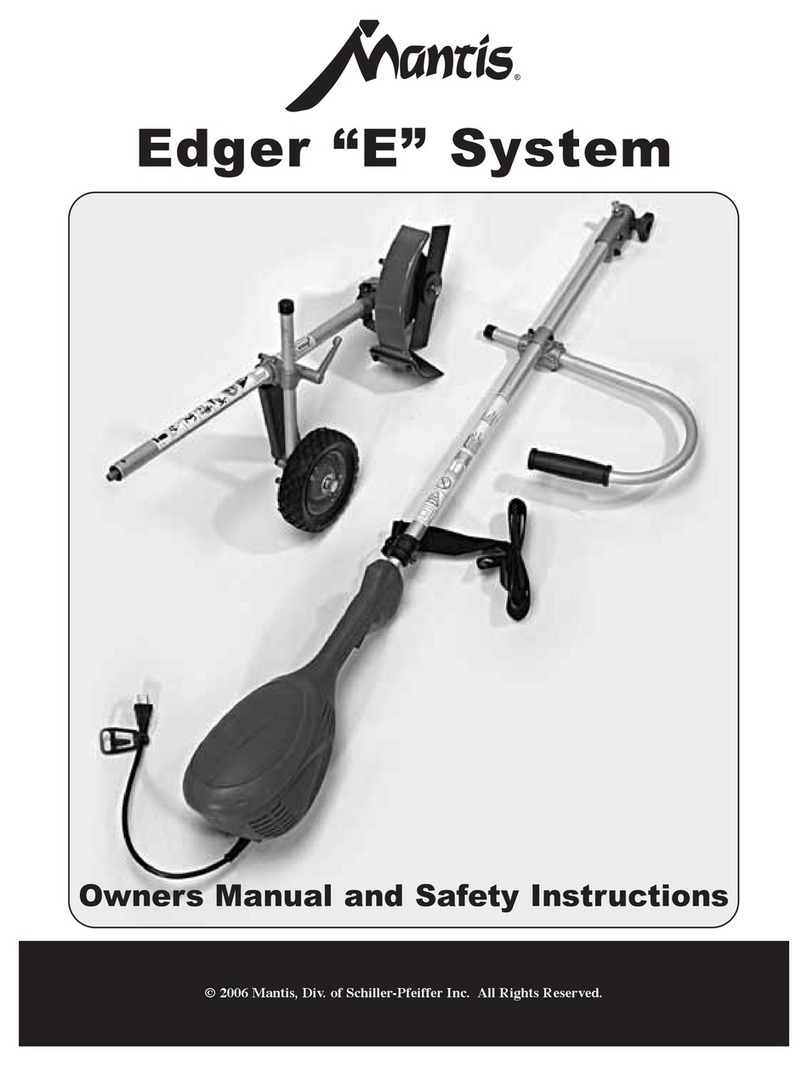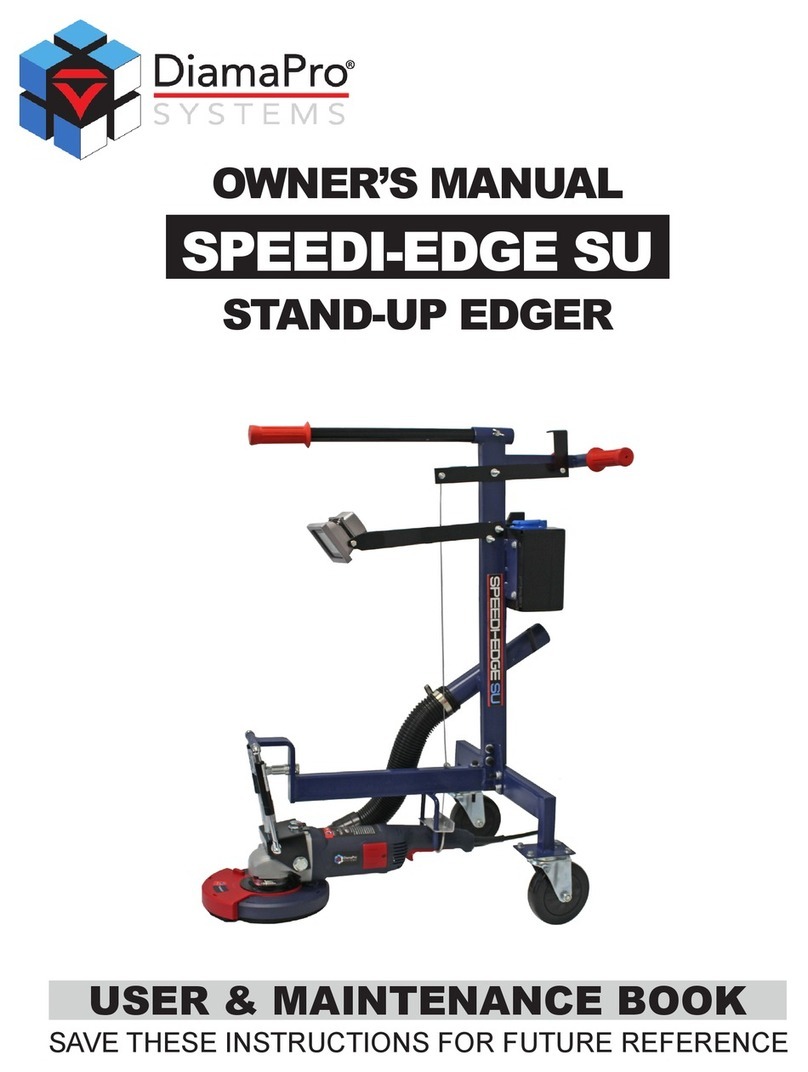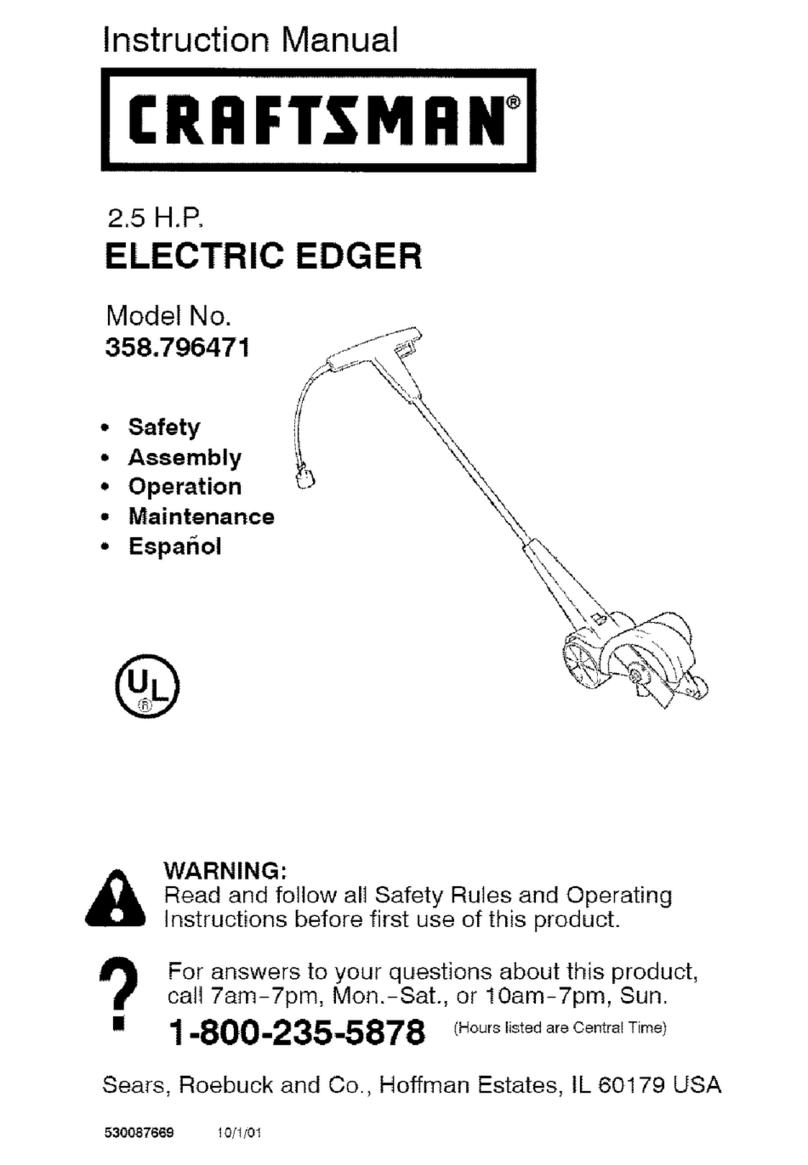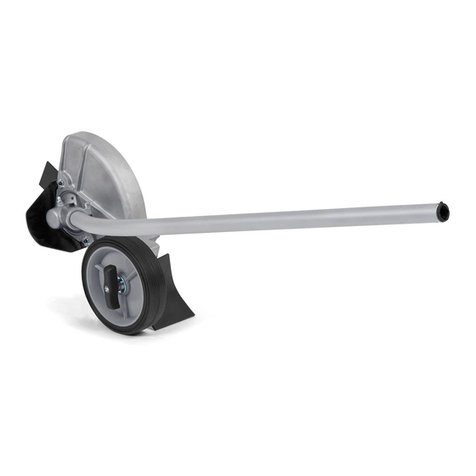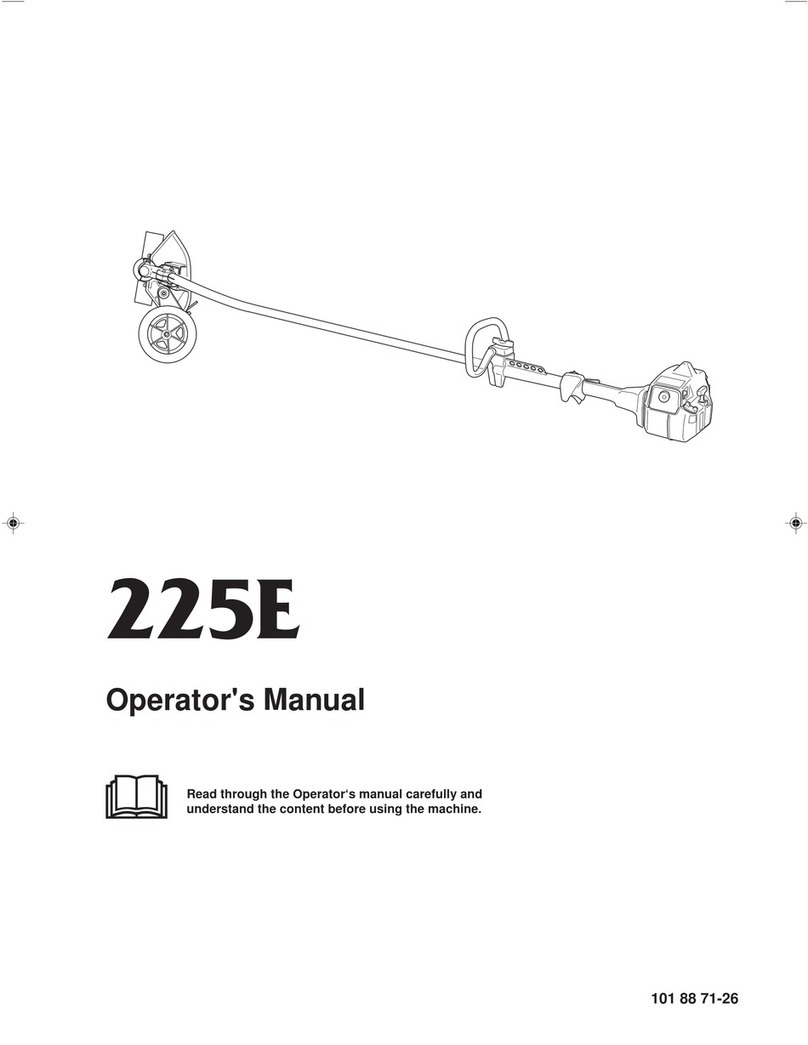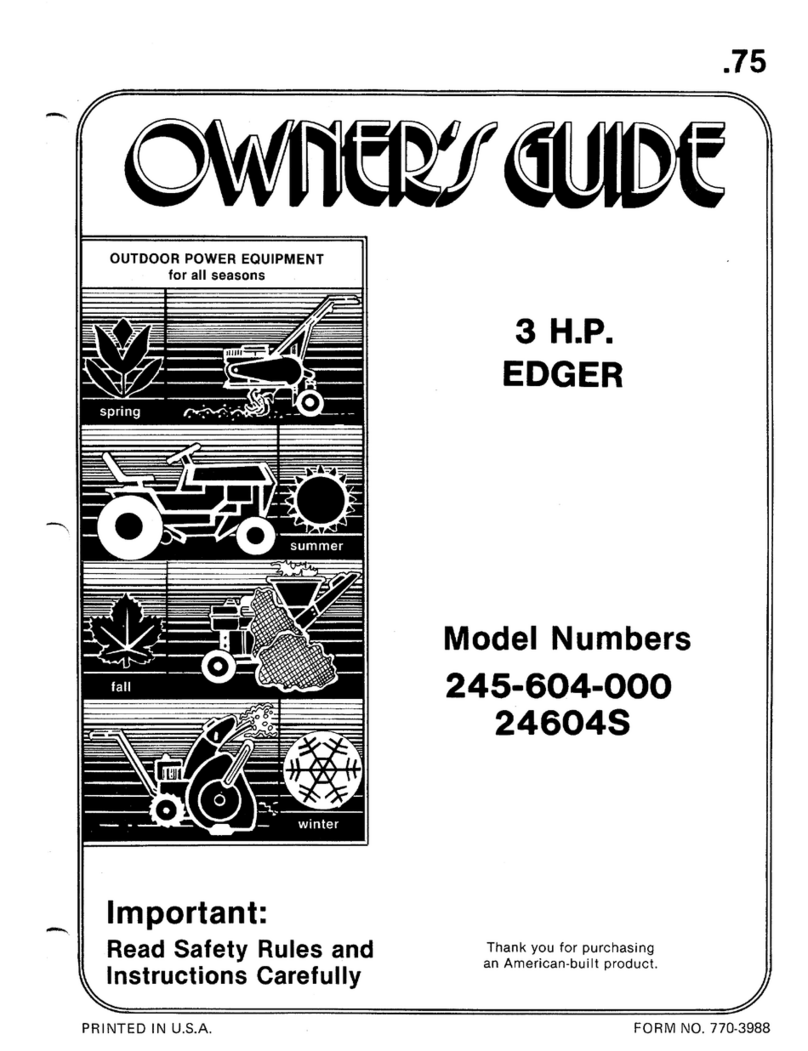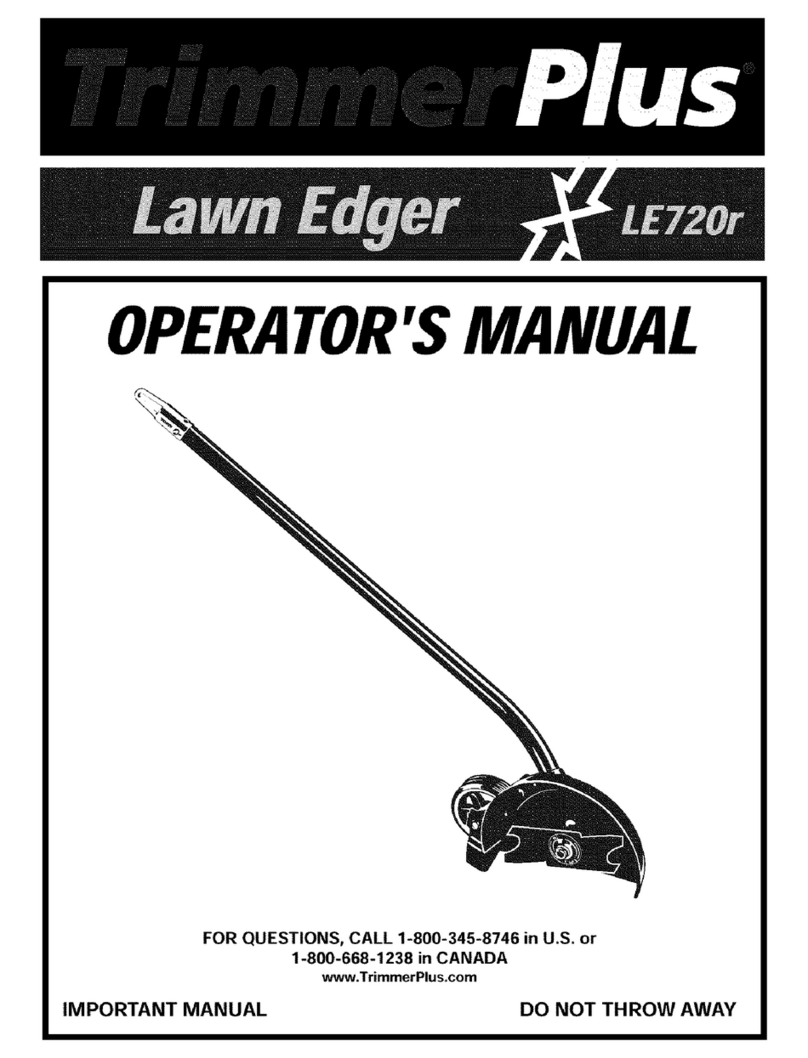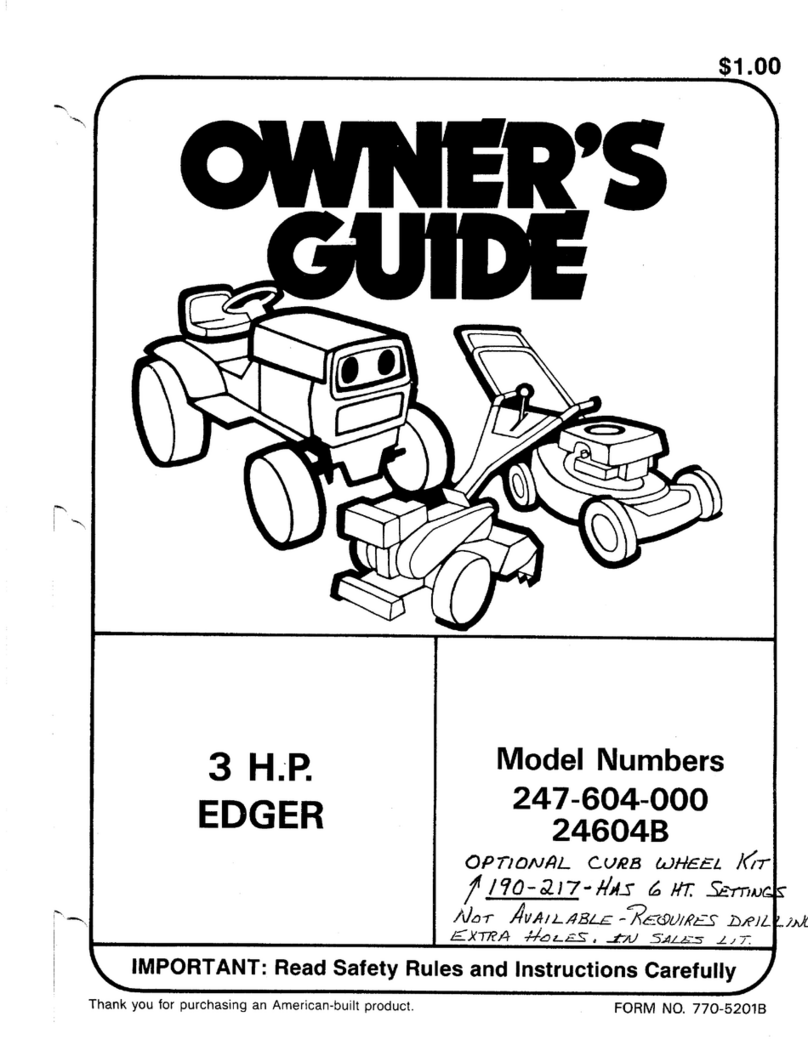Mantis Edger User manual

OWNER’S
MANUAL

Welcome To The World Of Mantis Gardening!
Here’s your new Mantis Edger...
designed for proud homeowners
who want to make their yard look
like a showcase!
With your new Mantis Edger,
you’ll have the neatest edge in the
neighborhood. The patented
cross-blade system cuts through
overgrown grass quickly and easi-
ly. It’s ideal for edging in confined
or narrow areas where traditional
wheeled edgers can’t reach.
Once you know how to use your
Mantis Edger correctly, we guaran-
tee you’ll love it. So first, please
read this manual and watch the
enclosed video. They show, step
by step, how to use your edger
safely and how to get the best
edging results.
2
Table of Contents
Safety Rules & Warnings ........................... 3
Safety Decals ............................................. 4
Engine & Fuel Warnings ........................... 4
Assembly ................................................... 6
Edger Diagram ........................................... 7
Mixing Fuel ............................................. 10
Starting Instructions ................................ 11
Additional Information .......................... 12
What to Do Just in Case .......................... 13
Edging Instructions ................................. 14
Blade Replacement .................................. 16
Maintenance ............................................ 17
Storage ...................................................... 20
Troubleshooting Tips .............................. 22
Specifications .......................................... 24
Service Maintenance Guide ..................... 24
Mantis Edger Assembly Layout ............... 26
Engine Parts Assemblies .......................... 28
Limited Warranty Information ............... 32

Safety Rules & Warnings
You will notice throughout this Owner’s Manual Safety Rules and Important Notes.
Make sure you understand and obey these warnings for your own protection.
I. Special Safety Information
II. Safety & Warnings
WARNING • DANGER
ATTENTION: THIS SYMBOL POINTS OUT
OUR IMPORTANT SAFETY INSTRUCTIONS.
WHEN YOU SEE THIS SYMBOL,
HEED ITS WARNING! STAY ALERT!
▲
!▲
!
▲
!
WARNING • DANGER
TO REDUCE THE POTENTIAL FOR ACCIDENTS, COMPLY
WITH THE SAFETY INSTRUCTIONS IN THIS MANUAL.
FAILURE TO COMPLY MAY RESULT IN SERIOUS PERSONAL
INJURY, AND/OR EQUIPMENT AND PERSONAL DAMAGE
▲
!▲
!
The engine exhaust from this product contains chemicals
known to the State of California to cause cancer, birth defects or other reproductive harm.
▲
!WARNING:
WARNING • DANGER
IMPROPER USE OR CARE OF THIS
EDGER OR FAILURE TO WEAR PROPER
PROTECTION CAN RESULT IN SERIOUS INJURY.
READ AND UNDERSTAND THE RULES FOR SAFE
OPERATION AND ALL INSTRUCTIONS IN THIS MANUAL.
WEAR HEARING AND EYE PROTECTION.
▲
!▲
!
3

III. Safety Decal Information
An important part of the safety system incorporated
in this edger are the warning and information
decals found on various parts of the edger.
These decals must be replaced in time; it is
your responsibility to replace these decals
when they become hard to read. The
location and part numbers of these
decals are illustrated on page 27.
DIRECTION OF ROTATION
ROTATING BLADE
WARNING • DANGER
IF THE EDGER IS USED IMPROPERLY OR SAFETY PRECAUTIONS ARE NOT
FOLLOWED, THE USERS RISK SERIOUS INJURY TO THEMSELVES AND OTHERS.
READ AND UNDERSTAND THIS MANUAL BEFORE ATTEMPTING TO OPERATE THIS EDGER.
▲
!▲
!
IV. Warnings - Do’s
Read and understand the owner’s
manual. Pay particular attention
to all sections regarding safety.
Always keep a firm grip on both handles
while the blade is moving and/or the engine is
running. BE AWARE! The blade may coast after
throttle trigger is released. Make sure blade has
come to a stop and engine is off before letting
go of the edger.
Always maintain a firm footing and good
balance. Do not overreach while operating the
edger. Before you start to use the edger, check
the work area for obstacles that might cause
you to lose your footing, balance, or control
of the machine.
Always keep area clear of children, pets,
and bystanders.
Always stay alert. Watch what you are
doing and use common sense. Do not operate
edger when fatigued.
Always dress properly. Do not wear loose
clothing or jewelry, which may get caught in
moving parts. Use sturdy gloves. Gloves reduce
the transmission of vibration to your hands.
Prolonged exposure to vibration can cause
numbness and other ailments. Wear non-skid
footwear to ensure secure and proper footing.
Always wear ear and eye protection.
Eye protection must meet ANSI Z 87.1. To
avoid hearing damage, we recommend hearing
protection be worn whenever using the equip-
ment.
Always keep a safe distance between two
or more people when working together.
Always inspect your edger before each use
and ensure that all handles, guards and fasten-
ers are secure, operating and in place.
Always maintain and examine your edger
with care. Follow maintenance instructions
given in manual.
Always store edger in a sheltered area (a dry
4
100603
100602
100601

place) not accessible to children. The edger, as
well as fuel, should not be stored in a house.
V. Warnings - Don’ts
Don’t use edger with one hand. Keep both
hands on handles with fingers and thumbs
encircling the handles, while blade is moving
and engine is running.
Don’t overreach. Keep a good footing at all
times.
Don’t attempt to clear blade while the
engine is on. Never try to remove jammed
material before switching the engine off and
making sure the blade has stopped completely.
Don’t allow children or incapable people
to operate this edger.
Don’t operate while under the influence
of alcohol or drugs.
Don’t attempt to repair this edger.
Have repairs made by a qualified dealer or
repairman. See that only original Mantis
parts are used.
WARNING • DANGER
HANDLE FUEL WITH CARE; IT IS HIGHLY FLAMMABLE. FUELING A HOT ENGINE OR NEAR AN IGNITION
SOURCE CAN CAUSE A FIRE AND RESULT IN SERIOUS PERSONAL INJURY AND/OR PROPERTY DAMAGE.
▲
!▲
!
VI. Engine/Fuel Warnings - Do’s
Always use fresh gasoline in the fuel mix-
ture. Stale gasoline can cause damage.
Always pull starter cord slowly until
resistance is felt. Then pull cord rapidly to
avoid kickback and prevent arm or hand
injury.
Always operate engine with spark
arrestor installed and operating properly.
The use of spark arrestor mufflers is required by
law in the state of California (Section 4442 of
the California Public Services Code), as well as
in other states or municipalities. Federal laws
apply on federal lands.
VII. Engine/Fuel Warnings - Don’ts
Don’t fuel, refuel or check fuel while
smoking, or near an open flame or other igni-
tion source. Stop engine and be sure it is cool
before refueling.
Don’t leave the engine running while
the edger is unattended. Stop engine before
putting the edger down or transporting from
one place to another.
Don’t refuel, start or run this edger
indoors or in an improperly ventilated area.
Don’t run engine when electrical system
causes spark outside the cylinder. During
periodical checks of the spark plug, keep plug a
safe distance from cylinder to avoid burning of
evaporated fuel from cylinder.
Don’t check for spark with spark plug or
plug wire removed. Use an approved tester.
Don’t crank engine with spark plug
removed unless spark plug wire is disconnect-
ed. Sparks can ignite fumes.
Don’t run engine when the odor of gasoline
is present or other explosive conditions exist.
Don’t operate the edger if gasoline is
spilled. Clean up spill completely before start-
ing engine.
Don’t operate your edger if there is an
accumulation of debris around the muffler and
cooling fins.
Don’t touch hot mufflers, cylinders or
cooling fins, as contact may cause serious
burns.
5

Assembly
WARNING • DANGER
IMPROPER ASSEMBLY OF THIS EDGER
CAN RESULT IN SERIOUS INJURY.
MAKE SURE TO FOLLOW ALL
INSTRUCTIONS CAREFULLY.
IF YOU HAVE ANY QUESTIONS
ABOUT THE EDGER ASSEMBLY,
CONTACT YOUR LOCAL
AUTHORIZED MANTIS DEALER
▲
!▲
!
Your Mantis Edger comes partially assembled;
you must install the handlebars and clip in
the throttle cable. The Mantis Edger can be
assembled by one person, but will be easier
with help from a second person. Assembly
will take just a few minutes if you follow the
directions.
First, take all items out of the carton.
Save the cardboard box to prop up the
engine for ease of assembly.
The list on page 7 shows the parts that come
with your edger. Check to make sure you
have all of them. The bag of hardware
is in the plastic bag containing the Owner’s
Manual and Video.
To assemble your Mantis Edger, you’ll need a
flat head screwdriver. We suggest that you
first install all nuts and bolts only “finger
tight” - that is, one-half to one full turn -
then, fully tighten after you’ve completed
assembly.
The nuts are self-locking, but you
must use a screwdriver to tighten
them completely.
6

KEY # DESCRIPTION QTY PART #
1Screw M5 x 36 mm 4 100500
2Nut Nyloc 5mm 4 100501
Main Body 1
44 Handle Right 1 100225
45 Handle Left 1 100226
46 Handle Cross Brace 1 100227
48 Handle Clamp 1 100532
52 Bolt 1/4” x 5.5” 1 100533
53 Knob 1 100232
Mantis Edger Parts List
7
1
1
1
1
2
2
2
46
53
48
52
45
44
see pages 26 & 27 for parts explosion
NOTE: Please use the Part No.
when ordering any parts

Step 1 Step 2
Step 3 Step 4
Insert the bolt through the right handle (with
the throttle trigger) and through the main
body of the Edger with the point of the plas-
tic washer facing down towards the blades.
After taking all parts out of the carton, turn
the cardboard box over and rest the engine
on top of it for ease of assembly.
Slip the flat handle clamp (key #48) onto the
long bolt (key #52) so that the hex head fits
into the recessed area.
Place the second handle over the bolt that
now protrudes from the other side and secure
it with the large plastic wing nut from the
hardware bag. Do not overtighten the wing
nut.
8

Step 5 Step 6
Step 7
Holding the nut in place, tighten the screw
on each side with a flat head screwdriver.
Place the handle cross brace (key #46)
between the handles and lay the throttle
cable and wire into the clips of the right-
hand handle brace.
Line up the holes in the brace with the holes
in the handle tubing and attach the brace
with one screw (key #1) and one nut (key #2)
on each side.
Your Mantis Edger is now fully assembled!
9

Your Mantis Edger comes with a free pre-
measured bottle of two-cycle engine oil.
Here’s how to mix the oil with the gas.
1. Pour 1/2 gallon of the gasoline into a safe
one gallon container. Do not mix the fuel
and oil in the engine fuel tank.
2. Add the Mantis two-cycle engine oil
(2.6 ounces pre-measured) to the gasoline
and mix. Then add the other 1/2 gallon
of gasoline. (50:1 ratio)
3. Screw the cap onto the gasoline can, and
swirl the can to blend the oil and gas.
4. Carefully pour the fuel mix into the
Mantis Edger’s fuel tank. After putting
the fuel tank’s cap back on, wipe up any
spilled fuel from tank and gasoline can.
IMPORTANT:
Two-cycle fuel separates and ages. Do not
mix more than you will use in a month.
Using old fuel can cause difficult starting
or engine damage. Shake fuel container to
thoroughly mix fuel before each use. Do not
attempt to run your engine on gasoline only;
use the proper fuel mixture.
Fuel Mix and Fueling
WARNING • DANGER
FUEL IS EXTREMELY FLAMMABLE. HANDLE IT WITH CARE. KEEP AWAY FROM
IGNITION SOURCES. DO NOT SMOKE WHILE FUELING YOUR EQUIPMENT.
▲
!▲
!
Your Mantis Edger is powered by a two-stroke, air cooled
engine which requires a fuel mixture of gasoline and
two-cycle oil.
Use a mixture of 50 parts unleaded regular gasoline and
1 part two-cycle oil (50:1). Use branded 89 octane
(R+M+2) unleaded gasoline or gasohol (max. 10% ethyl
alcohol, or 15% MTBE, no methyl alcohol).
Need more pre-measured engine oil? Contact
your local authorized Mantis dealer.
Remember...
•Always mix two-cycle oil with gasoline
before fueling your edger. Never, ever run
your Edger on gasoline alone. This will ruin
your engine and void all warranties.
•Always use a clean gas can and always use
unleaded gas.
•Never try to mix the oil and gasoline in the
engine fuel tank.
•Always mix gasoline and oil in the proper
proportions: 1 gallon of unleaded gasoline
to 2.6 ounces of two-cycle engine oil.
(50:1 ratio)
IMPORTANT NOTE:
DO NOT use old or stale oil/gasoline
mixture. Always use the proper
oil/ gasoline mixture. If you do not,
your engine will suffer rapid,
permanent damage and you will
void the engine warranty.
10

Starting Instructions
To Start Your Mantis Edger for the First Time:
Fill the fuel tank with the proper oil/gasoline mixture
(see previous section). Hand tighten the gasoline cap
until it’s just snug.
Place the start/stop switch into the “start” position
(Picture 1).
Lay the Edger flat on the ground for the following steps.
Pull out the choke button to close the engine choke
(Picture 2).
Locate the purge bulb on the upper right of the
engine, in front of the fuel tank (Picture 3). It sends fuel
into the carburetor for easy starting. Press the purge bulb
until you see fuel flow through the clear fuel return line.
Since you’re starting “cold,” you may need to press six
to eight times. As soon as fuel starts flowing through the
clear fuel line, stop pressing!
Place one foot on the cross-brace, and pull the starter
cord (Picture 4) slowly until resistance is felt. Then give
the recoil starter cord a few short, brisk pulls until the
engine fires. During cold starting, you may need to pull
at least three or four times before the engine fires
(coughs and sputters).
NOTE: When the choke is closed, never pull the cord
more than four or five times. Overpulling may cause
flooding. Also, bear in mind that, when the engine fires,
it only coughs or sputters, and will not run on choke.
Push in the choke button to open the choke (Picture 5)
Then, pull the starter cord again. The engine should
start and run. Let the
engine warm up two to
three minutes before using.
Follow these steps whenever
you are starting the engine
“cold,” or when the engine has
run dry and you have just
added fuel. Remember, always
use short, brisk pulls. Don’t
give the cord a long, forceful
yank. And, do not let the
cord snap back into the
starter housing.
Picture 1
Picture 2
Picture 3
Picture 4
Picture 5
WARNING
AVOID ACCIDENTAL
BLADE ENGAGEMENT
DO NOT SQUEEZE THE
THROTTLE TRIGGER
WHEN STARTING. MAIN-
TAIN PROPER IDLE
SPEED ADJUSTMENT
(3000-3200 RPM).
▲
!▲
!
11

Starting a Warm Engine
Slide start/stop switch to the START position.
Push choke button into the RUN (open) position.
If there is no fuel in the clear return line, push primer
bulb 3-4 times or until fuel is visible in the line.
Pull starter rope using short pulls, 1/2 to 2/3 of the rope
length.
If engine fails to start in 4 pulls, use “First Time” starting
procedure on page 11.
With engine running and both hands on the handles,
squeeze throttle trigger gradually to increase the engine
speed and engage the blade.
Starting Instructions ...continued...
Never use starting
fluids as they will
cause permanent
engine damage. Using
them will void the
engine warranty.
Before you use the
tiller, read the Safety
& Warning rules on
pages 3-5.
Additional Information WARNING • DANGER
IF ENGINE DOES NOT STOP WHEN SWITCH
IS PUT IN THE STOP POSITION, RELEASE
THE THROTTLE, ALLOW ENGINE TO IDLE.
PUT THE EDGER DOWN AND PULL
THE CHOKE BUTTON OUT TO COLD
START (CLOSED) POSITION.
CHECK AND RETURN START/STOP
SWITCH TO ON POSITION BEFORE
STARTING ENGINE AGAIN.
▲
!▲
!
won’t turn unless you squeeze the throttle
lever on the handlebars. And, when you
release the throttle lever, the blade will stop.
A Tip for Extending Your
Engine’s Life
After you start your engine, let your edger
warm up for two to three minutes before you
use it. Then, before you put your tiller away,
let it idle for a minute to give the engine a
chance to cool down.
How to Stop
the Engine
Simply push the
start/stop switch
to “stop” (see
picture). This
will stop the
engine instantly.
If it should ever
fail to do so, just pull out the choke button.
The engine will stop at once.
About the Choke
The choke controls the amount of air drawn
into the engine. Your edger will run only
if the choke is open - that is, if the choke
button is pushed in.
A Special Feature (with the idle
set and the engine running)
Even when the engine is running, the blades
12

What To Do Just In Case
If you follow the normal starting procedure, you should
have no problem starting your edger. But, just in case you
do have problems, here’s what to do.
Make sure the start/stop switch is on “start.” You’d be sur-
prised how many people forget to slide the switch into the
“start” position.
If the switch was on “stop” when you pulled the cord, you
may have flooded the engine.
Starting a Flooded Engine
• First, examine the spark plug. Use a 3/4 inch spark plug
wrench (Picture 1).
• Remove the cap over the spark plug.
• Unscrew the spark plug (Picture 2).
If the end of the spark plug is wet, the engine may be
flooded. Make sure the switch is in the stop posi-
tion, disconnect spark plug wire and remove plug.
Use a paper towel or a clean rag to dry the spark
plug, then, with the spark plug out of the engine,
pull the starter cord several times. Shake the fuel
out of the inside of the plug and air dry. Next,
replace the spark plug. Use the wrench to tighten it and
replace the cap. Next, put the switch in the start position
and pull the choke button out. Pull the starter cord three
or four times until the engine coughs or sputters. Open the
choke (push the choke button in) and pull the cord a few
times. The engine should start and run.
Picture 1
Picture 2
Picture 3
WARNING
MAKE SURE THE START/STOP SWITCH IS IN THE
STOP POSITION. KEEP PLUG WIRE AWAY FROM
ENGINE TO AVOID UNINTENTIONAL SPARK.
▲
!▲
!
IMPORTANT NOTE:
To avoid possible damage to the
Threads, do not try to remove the plug
from a hot aluminum cylinder head.
If the end of the spark plug is dry,
check to see if the fuel line is
blocked. The fuel line runs from
the fuel tank to the carburetor. Pull
it off at the carburetor end. Fuel
should drip slowly from the line.
Wipe off any excess or spilled fuel.
If fuel does not drip from the line,
check the line for any bends or
pinches (Picture 3). Kinks in the
line restrict the flow of fuel to the
engine. Just straighten out the line.
Reconnect. Then follow the normal
starting procedure.
13

Here’s Another Way to Start
Your Mantis Edger
If you follow the previous steps and your
engine still won’t start, try this:
1. Slide the switch to “start.”
2. Push the choke button to open the choke.
3. Press the plastic bubble 5 to 6 times.
4. Give the starter cord a few short, quick
pulls. The engine should start and run.
5. If the engine does not start, then pull out
the choke button to close the choke. Pull the
starter cord four to five times. The engine
should sputter and cough.
6. After the engine sputters, push the choke
button in. Then pull the starter cord. The
engine should start and run.
What To Do Just In Case ...continued...
7. If the engine still does not start, repeat
steps 2 through 6.
8. If the engine still does not
start, call your local authorized
Mantis Dealer.
IMPORTANT NOTE:
Never use starting fluids as
they will cause permanent
engine damage. Using them
will void the engine warranty.
Before you use the edger, read
the Safety & Warning rules on
pages 3-5.
Edging Instructions
The Mantis Edger is very easy and simple
to use. For some people, it may take a few
edgings to become an expert.
Thoroughly inspect the area where the edger is to be used
and remove all stones, sticks, wires, and other foreign
objects.
Adjust blade height (Picture 1). With a new blade,
try the second hole closest to the operator.
With both arms fully extended downward (Picture 2), hold
both handle grips firmly. With the engine running, pull
the throttle trigger to increase engine speed to full throttle.
Always run the engine at full throttle when edging.
If blade is not deep enough, or if digging is too deep,
adjust blade height or slightly raise or lower handles to
suit depth required. (Picture 3). However, it is always more
comfortable and relaxed to have arms fully extended
downward.
Picture 1
Picture 2
14

As cutting actions begins, push the Mantis Edger for-
ward so that the blade can cut the edge as you move for-
ward. (Picture 4).
Continue at a moderate pace until you are familiar with
the controls and the handling of the Mantis Edger.
If blade jams or stops in the ground, lower handles or
pull back unit and recommence (Picture 5). Control
engine and cutting speed to suit work being done When
cutting efficiently, engine speed should be full throttle
under load.
Edging Along a Concrete Edge
For the position of the blade, align the edge guide on
top of the blade cover with the edge of the concrete. If
the blade hits the concrete, lower the handle and reposi-
tion the blade at the side of the concrete. Even if the
grass is growing over the concrete and you cannot see
the edge, you can feel the edge of the concrete
with the rotating blade by slightly tilting the
handles of the edger sideways, away from the
concrete, so that the blade tilts towards the con-
crete and touches or “kisses” the concrete edge
and acts as a guide (Picture 6). Edger blades are
made from high tensile hardened spring steel and will
last a long time. Once the edge is established, the second
and subsequent times around are very fast.
Sideways Tilting
Lower either the left or right handle to achieve angled
cutting along walls or fences (Picture 7).
Picture 3
Picture 4
Picture 5
Picture 6
Picture 7
WARNING
KEEP INSIDE OF BLADE GUARD CLEAN, ESPECIALLY
IN WET CONDITIONS. A CLOGGED GUARD CAN SLOW
DOWN OR STOP BLADE ROTATION AND MAY CAUSE
DAMAGE TO AUTOMATIC SAFETY CLUTCH. ALWAYS
OPERATE BLADE AT FULL THROTTLE WHEN EDGING.
▲
!▲
!
IMPORTANT NOTE:
The Mantis Edger is equipped with a cen-
trifugal clutch. DO NOT run edger engine
at low speeds or, if blade is jammed, at
high engine speeds as clutch shoes will
prematurely wear out and cause damage.
15

Blade Replacement
1. Stop engine. Unplug the spark plug wire. Clean
area around dust cover and pry debris out with a screw-
driver (Picture 1).
2. Through dust cover, place 14mm or 9/16” socket
wrench. On blade end of shaft, place 18mm or adjustable
wrench on blade nut (Picture 2).
3. Unscrew nut counter-clockwise (normal right hand
thread).
4. Remove one small washer, one large washer and two
blades (Picture 3). Before installing blade and washers,
clean all grit and grease. Assemble these parts clean and
dry. Fit large washer, new blades with spiggots of one blade
interlocking with holes on opposite blade, large washer,
two small washers, and nut. Tighten nut.
5. Clean plastic dust cap and housing; press back by gently
tapping into place. Clean inside blade cover of any built-
up dirt.
Loose Blade
Follow steps 1 and 2 of Blade Replacement and tighten nut
clockwise.
Picture 1
Picture 2
Picture 3
Picture 4
WARNING
USE ONLY MANTIS BLADES. OTHER BLADES
HAVE LARGER SIZE HOLES (1/2”) WHICH WILL
CAUSE OUT-OF-BALANCE VIBRATIONS WHICH
WILL DAMAGE UNIT AND CAUSE INJURY.
▲
!▲
!
WARNING
DO NOT RUN ENGINE
WITHOUT BLADE TIGHTENED
TO BLADE SHAFT AS GEAR
DAMAGE WILL OCCUR.
▲
!▲
!
Lubrication of Gears
There is usually sufficient grease to last at least 4 years or
100 hours of domestic use before topping it up. The grease
in the gear case should be filled up according to use by
adding light, free-flowing grease (available from Mantis,
P/N #9985) through screw hole marked “fill” (Picture 4).
Use a suitable filling gun or squeeze grease pack. Remove
screw marked “bleed.” Squeeze in 3-4 pumps of grease,
until it comes out of the bleed hole. Refit fill screw.
NOTE: Do not use light or heavy gear oil as
it might leak out. If gear case shows leakage,
tighten all screws or replace O-ring. Refill casing.
16

Maintenance
Check the Air Filter Often
A wet or dirty air filter can affect the way your engine
starts, performs, and wears. So, it’s a good idea to check
your air filter at least once a month.
If you work in dusty soil, or if you want to be on the
safe side - then check your filter more often (for
instance, before each use). But be sure to replace it at
least once a year, in the spring or fall. Clean or change
it as needed. It is recommended to change the air filter
yearly.
How to Check, Clean, and Change the Air Filter
1. Loosen the wing nut on the side of the air-cleaner
cover (Picture 1).
2. Take off the cover. Make sure to clear the choke
button (Picture 2).
3. The air filter is the felt pad on the inside of the
air-cleaner cover. Check whether it is soiled or moist.
4. If the air filter needs cleaning or no longer fits
properly, remove it. Just lift an edge carefully and “peel”
it out (Picture 3).
5. Use a brush to remove debris from the pad.
6. If the air filter is so dirty that it won’t come clean,
you must replace it or severe engine damage will occur.
Contact your local authorized Mantis dealer.
7. Insert your clean filter inside the air-cleaner cover.
Installing the filter incorrectly will cause engine damage
and void the warranty. Fit the cover back over the air
cleaner (Again, make sure to clear the choke button).
8. Tighten the wing nut to secure the cover.
Picture 1
Picture 2
Picture 3
IMPORTANT!
Make sure filter is “seated” properly in
the cover. The filter must fit snugly inside
the rim that holds the filter into place.
IMPORTANT NOTE:
Please check the lip
on the Air Cleaner
Cover. If the lip is
chipped or cracked, it
should be replaced. This
will prevent dirt from
being ingested through
the carburetor into the
inside of the engine.
17

Maintenance ...continued...
Clear Blockages From the Fuel Line and Filter
After you’ve used your Edger for a few seasons, check for
blockages in the fuel tank and fuel filter. Such blockages
can keep your Edger from starting.
Clear any blockages you see in the tank, fuel filter, or
fuel line. Remember: The fuel filter is located inside the
tank (Picture 1). Then, use the normal starting procedure
to start your Edger.
What To Do If Your Engine Idles Too High
What if your engine runs too fast...or if the blades
turn the instant you start the Edger? You may need
to adjust the idle screw ( Picture 2, or Key #25 under
“Carburetor” on page 28) by itself, right below the H
and L screws. Gently turn it counter-clockwise. You’ll
know you’ve adjusted it correctly when the blade does
not turn at low idle.
If you continue to have idle problems, you may need to
adjust the throttle cable.
First, locate the metal triangle at the end of the throttle
cable (Picture 2). The idle screw must touch this triangle.
But, if the throttle cable’s too tight, you’ll see a gap
between the idle screw and the triangle.
To fix this, loosen the top nut that holds the throttle
cable in place (Picture 3) (Use a 10mm wrench or an
adjustable wrench). Then, slide the cable down until you
close the gap between the triangle and the idle screw
(Picture 4). Now, tighten the bottom nut that holds the
throttle cable.
Locate the metal “button” on the triangle. This is the
swivel. The large end of the throttle cable must be inside
the slot in this swivel (Picture 4).
Picture 1
Picture 2
Picture 3
Picture 4
18
idle screw

What To Do If Your Engine
Runs “Rough”
If your engine runs “rough” or stalls, you
may need to adjust the carburetor and idle
screws.
If you remove the air-cleaner cover, you’ll see
the two carburetor adjustment screws, next
to the black choke button.
The “RED” screw is the HIGH-speed adjust-
ment...The “WHITE” screw is the low speed
adjustment.
Start the engine and let it run for two to
three minutes. “FLASH” the choke several
times during the warm-up to clear any air
from the fuel system.
Then, stop the engine after it reaches operat-
ing temperature.
Now, turn the RED, high-speed screw count-
er-clockwise all the way to the stop...Then,
turn the WHITE, low-speed screw halfway
between the counter-clockwise and clockwise
stop positions.
Now restart the engine to finish the carbure-
tor adjustment.
Run the engine at full speed two or three
seconds to clear out any excess fuel. Then
return to idle.
Now, accelerate the engine to full throttle
several times to check for a smooth transition
from idle to high speed.
If the engine hesitates, turn the WHITE, low-
speed screw counter-clockwise one-eighth of
a turn. Then, accelerate the engine.
Repeat the adjustment until you get a
smooth transition to high speed.
Cleaning the Muffler Screen
1. Take out the spark plug.
2. Remove the red cylinder cover (Key #19)
which is held on by two Phillips-head screws.
(Key #18).
3. You will see the metal screen fixture, held
on by 3 more Phillips-head screws (Key #26).
Remove the fixture.
4. Behind the fixture (Key #25) will be the
muffler lid (Key #24) and muffler lid gasket
(Key #23). The screen sits in the gasket.
5. If the screen (Key #22) is clogged with
deposits, it needs to be cleaned. Use carbure-
tor cleaner, and any brush that is not metal.
Brush the screen until you are able to see
through it.
6. If the screen remains plugged after
attempts at cleaning, it must be replaced.
Maintenance ...continued...
19

Storage
Each fall - or before you store your Mantis Edger for any
long period - be sure to take these measures:
1. Do not store your Edger with fuel still in it. Even under
ideal conditions, stored fuel containing ethanol or MTBE
can start to go stale in 30 days. And, since stale fuel has a
high gum content, it can clog the carburetor, which will,
in turn, restrict fuel flow. So, when you’re ready to
store your Edger, or will not be using it for more
than 2 weeks, drain the fuel tank completely. (Picture 2).
2. Next, restart the engine to make sure no fuel is left in
the carburetor. Then run the engine until it stops. This will
prevent gum deposits forming inside of the carburetor and
possible engine damage..
3. Disconnect the spark plug wire and remove the spark
plug. (Use a 19mm or 3/4” spark plug wrench.) Pour about
a teaspoon of clean, air-cooled oil through the spark plug
hole into the combustion chamber (Picture 3). Slowly pull
the starter cord two or three times to coat the inside of the
cylinder wall.
4. Inspect the spark plug and, if necessary, clean it. If you
need to replace it, buy a NGK-BPM7Y.
5. Install the spark plug, but leave the spark plug wire
disconnected.
6. Clean the air filter as described on page 17.
7. Clean dirt, grass, and other materials from the entire
machine.
8. Wipe the blade with oil or spray it with WD-40 to
prevent rusting.
9. Oil the throttle cable and all visible moving parts
(Do not remove the engine cover).
Picture 1
Picture 2
Picture 3
WARNING
DO NOT STORE IN AN AREA WHERE FUEL FUMES MAY
ACCUMULATE AND REACH A FLAME OR SPARK
▲
!▲
!
20
Table of contents
Other Mantis Edger manuals
Popular Edger manuals by other brands

Scotts
Scotts S20300 Operator's manual

Weed Eater
Weed Eater 530087456 Operator's manual
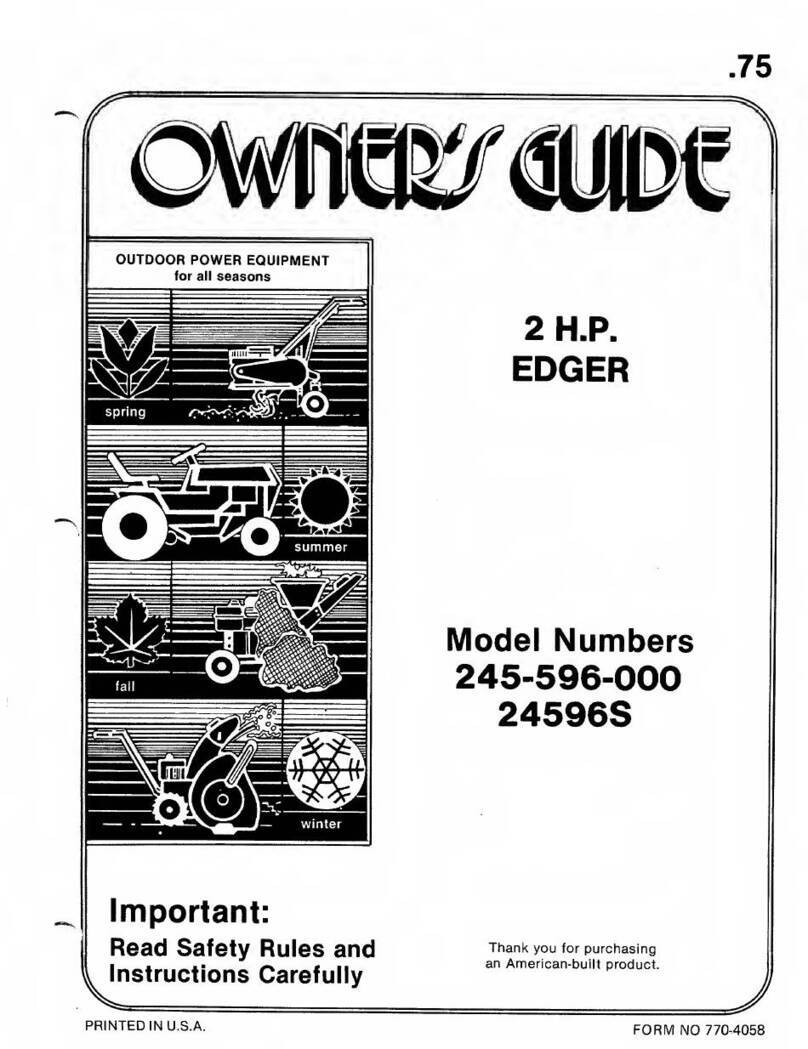
MTD
MTD 245-596-000 owner's guide
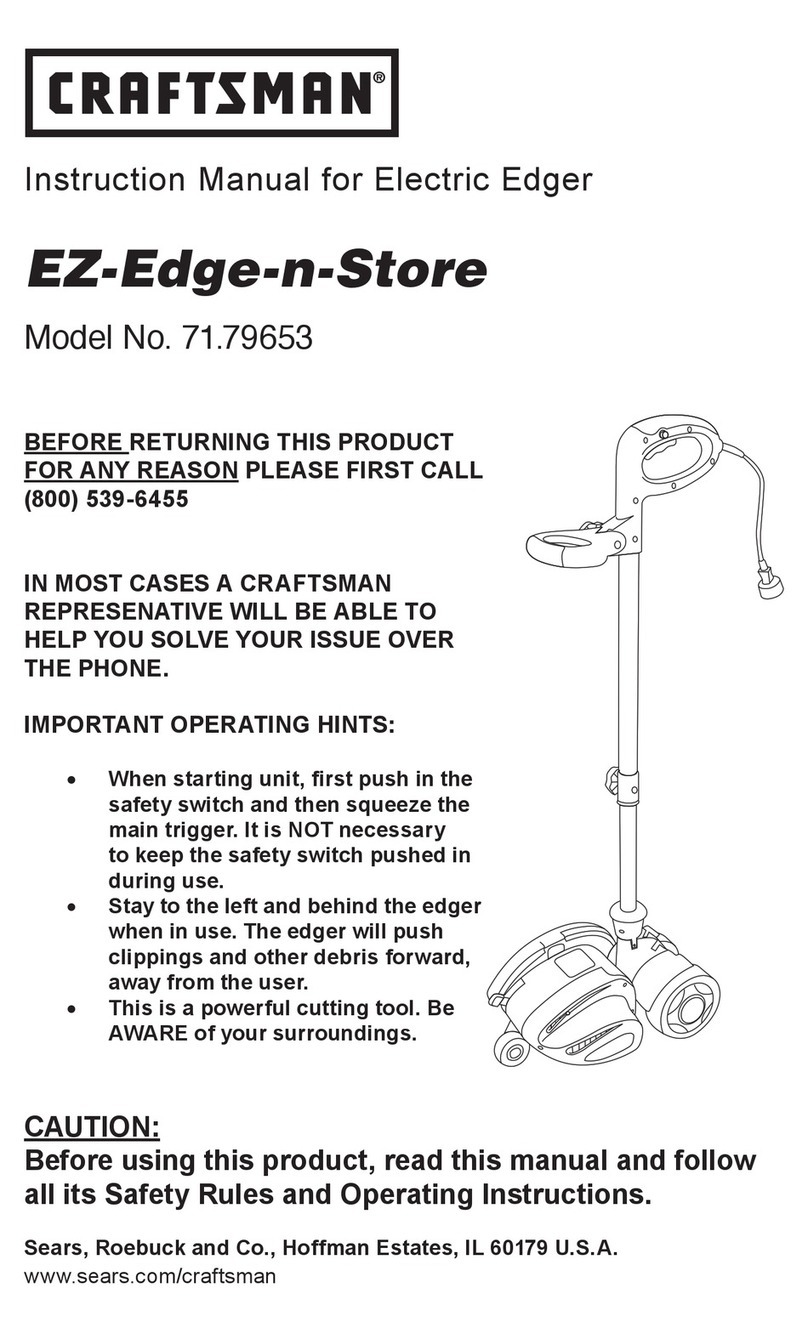
Craftsman
Craftsman EZ.Edge.n.Store 71.79653 instruction manual
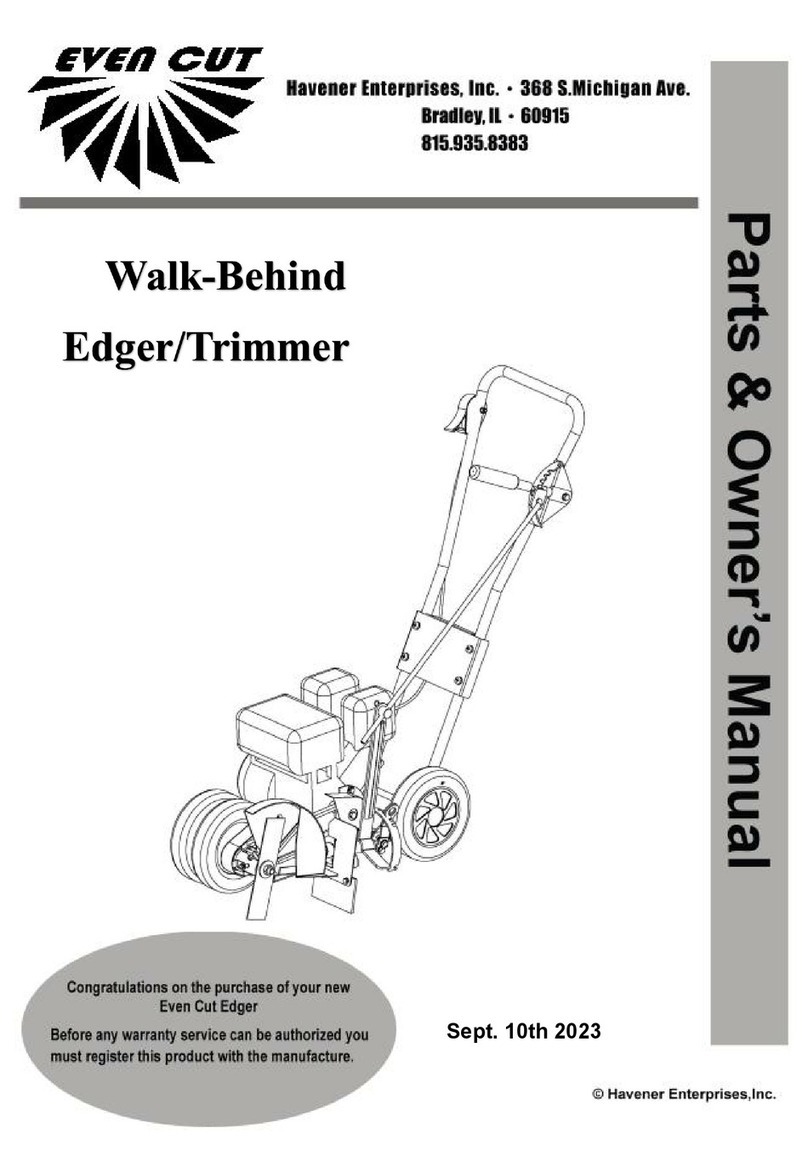
Havener Enterprises
Havener Enterprises EVEN CUT Parts & owner's manual
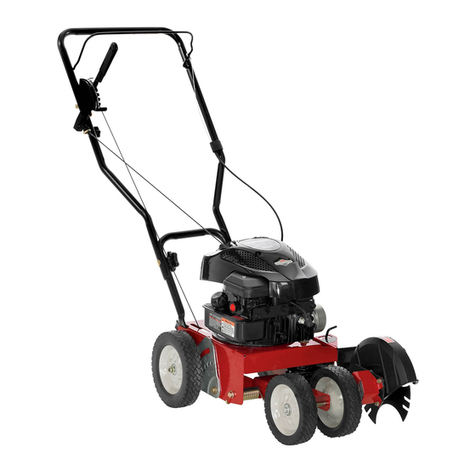
Craftsman
Craftsman 77246 - 158cc 4 Cycle Gas Edger 49 State Operator's manual
